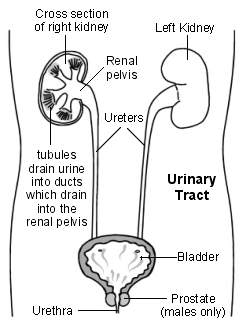
The two kidneys lie to the sides of the upper abdomen (the loins), behind the intestines, and either side of the spine. Each kidney is about the size of a large orange, but bean-shaped.
A large renal artery takes blood to each kidney. The artery divides into many tiny blood vessels (capillaries) throughout the kidney. Tiny structures in the kidneys called nephrons 'filter' the blood contained in the capillaries. Water and waste materials which filter through the walls of the capillaries into the nephrons form urine. Urine passes along thin channels (tubules) which are part of each nephron, into larger channels (ducts) which drain the urine into the renal pelvis (the inner part of the kidney).
Urine passes down a tube called a ureter which goes from each kidney to the bladder. Urine is stored in the bladder until it is passed out through the urethra when we go to the toilet.
The 'cleaned' (filtered) blood from each kidney collects into a large renal vein which takes the blood back towards the heart.
Some specialized cells in the kidneys also make some hormones, including:
Although it is normal to have two kidneys, we can live perfectly well with just one healthy kidney.
What is cancer?
Cancer is a disease of the cells in the body. The body is made up from millions of tiny cells. There are many different types of cell in the body, and there are many different types of cancer which arise from different types of cell. What all types of cancer have in common is that the cancer cells are abnormal and multiply 'out of control'.
A malignant tumour is a 'lump' or 'growth' of tissue made up from cancer cells which continue to multiply. Malignant tumours invade into nearby tissues and organs which can cause damage.
Malignant tumours may also spread to other parts of the body. This happens if some cells break off from the first (primary) tumour and are carried in the bloodstream or lymph channels to other parts of the body. These small groups of cells may then multiply to form 'secondary' tumours (metastases) in one or more parts of the body. These secondary tumours may then grow, invade and damage nearby tissues, and spread again.
Some cancers are more serious than others, some are more easily treated than others (particularly if diagnosed at an early stage), some have a better outlook (prognosis) than others.医学.全在.线www.med126.com
So, cancer is not just one condition. In each case it is important to know exactly what type of cancer has developed, how large it has become, and whether it has spread. This will enable you to get reliable information on treatment options and outlook. See separate leaflet called 'What are Cancer and Tumours' for further details about cancer in general.
What is kidney cancer?
There are several types of kidney cancer, but most cases are 'renal cell cancer'. This is sometimes called 'renal adenocarcinoma' or 'renal cell carcinoma' or 'hypernephroma'.
Renal cell cancer
This type of cancer develops from a cell in a kidney tubule which becomes cancerous. The cancer grows and forms into a tumour within the kidney. As the tumour grows:
Renal cell cancers can be divided into several 'sub-types' by looking at certain features of the cells under a microscope. For example, most are 'clear cell' renal cell cancers, but some other types occur such as 'sarcomatoid', or 'granular' renal cell cancers. Knowing the sub-type of the cancer can be important as some respond to treatment better than others.
Other types of kidney cancer
Some rare types of cancer arise from other types of cell within the kidney. For example:
The rest of this leaflet only discusses renal cell cancer.
What causes kidney cancer (renal cell cancer)?
A cancerous tumour starts from one abnormal cell. The exact reason why a cell becomes cancerous is unclear. It is thought that something damages or alters certain genes in the cell. This makes the cell abnormal and multiply 'out of control'. (See separate leaflet called 'What Causes Cancer' for more details.)
Many people develop kidney cancer for no apparent reason. However, certain risk factors increase the chance that kidney cancer may develop. These include:
What are the symptoms of kidney cancer?
Blood in urine
You may have no symptoms at first when the tumour is small. In many cases, the first symptom is to pass blood in the urine ('haematuria') which is usually painless. The blood in the urine may 'come and go' as the tumour bleeds from time to time. (There are many causes of blood in the urine apart from cancer such as bladder or kidney infections, inflammation of the kidney, kidney stones, etc. You should always report this symptom to your doctor, even if it goes, to clarify the cause of the bleeding.)
Other symptoms
Various other symptoms may occur, typically as the tumour becomes larger, and include:
As the cancer becomes larger you may feel generally unwell and lose weight. If the cancer spreads to other parts of the body, various other symptoms can develop.